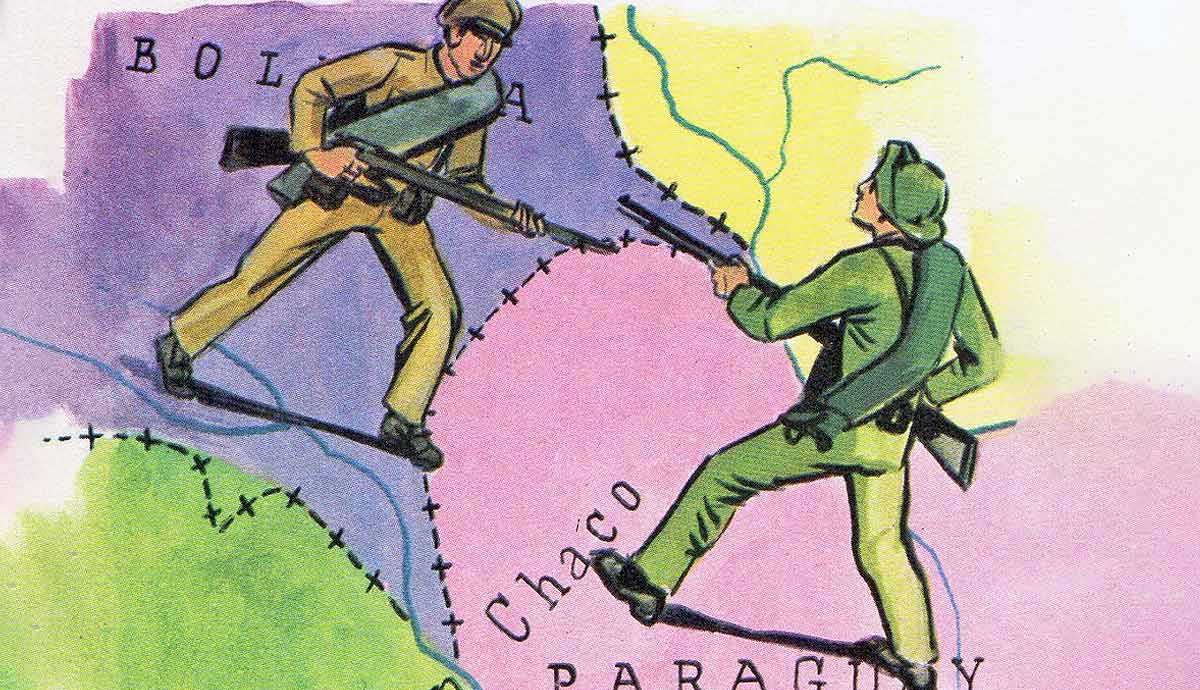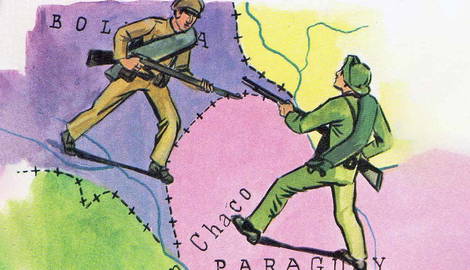
The Chaco is a semi-arid, lowland region that covers parts of Bolivia, Paraguay, Argentina, and small portions of Brazil. It is a tropical and subtropical region high in animal diversity and low in human population density.
Getting its name from the Quechua word chaqu meaning “hunting land,” it was this portion of South America that became the subject of a territorial dispute that left a bloody mark on the continent, as Paraguay and Bolivia clashed over the Chaco, a place they both believed was rich in oil.
What Caused the Rise in Tensions That Led to the Chaco War?

In 1929, the Treaty of Lima resolved territorial disputes between Peru and Chile over land west of Bolivia, which connected to the Pacific coastline. Bolivia had hoped to acquire a land bridge, but without the political influence, its plans were scuppered, and the nation found itself landlocked and bordering South America’s other landlocked country: Paraguay. Without a connection to the sea, it was believed by both countries that their economic future was in dire peril.
The only access to the sea was the Paraguay River which ran into the Atlantic. The territory east of this River was firmly established as Paraguay, but the area west of it became disputed, as both countries claimed it, and Bolivia sought to gain access to a vital lifeline. To make matters worse, oil companies had been prospecting in the area. Oil had already been found in the foothills of the Andes, and it was thought that the Chaco could be rich in oil too. With Grand Dutch Shell supporting Paraguay and Standard Oil supporting the Bolivian claim, the scene was set to degenerate into conflict.
Prior Disagreements

Bolivia and Paraguay had reasons to distrust each other and had had disagreements in the past that dated back several decades. The first went back to 1885 with the establishment of a port on the upper Paraguay River. Bolivian businessman Miguel Araña Suárez had assumed the land belonged to Bolivia, but it was actually part of Paraguay, and the Paraguayans forcibly evicted him with military force.
Over the next few years, Bolivia would make tentative steps into the region, attempting to establish outposts and solidify its claim to the region. Minor clashes between the two nations began in 1927 and escalated in a tit-for-tat fashion until an agreement was reached in September 1929.
This wasn’t, however, an end to the dispute. Both countries knew that full-scale war was inevitable, and an arms race ensued as both countries sought to expand their militaries for the conflict ahead.
The War Begins

In August 1932, Bolivia struck the first blow, capturing three Paraguayan outposts that Bolivian president Danial Salamanca had claimed were in the disputed zone. The action was an opportunistic attack and happened before the Bolivian army was even mobilized for war.
The Paraguayan response was quick. With a population only a third the size of Bolivia, the Paraguayans decided to mobilize hastily before the Bolivians could do so and gain the upper hand with a quick offensive. The first major engagement of the war lasted from September 7 to September 29, 1932. The Battle of Boquerón was an attempt by the Paraguayans to capture Fortín Boquerón, held by a few hundred Bolivian soldiers. Heavily outnumbered, the Bolivians were in a poor situation. A relief force failed to lift the siege, and the Paraguayans eventually forced their enemies to surrender.
To follow up this success, the Paraguayans marched on Fortín Arce, but when they arrived, it had been demolished, and the Bolivians had fled.
By December, the Bolivian mobilization had concluded, and with superior numbers and equipment, they were in high spirits, expecting a quick and relatively easy victory. Under the leadership of General Hans Kundt, the Bolivians were to strike at Fortín Nanawa, which was considered to be the most vital link in the Paraguayan defenses. If the Bolivians could break through there, they would be able to threaten the Paraguayan city of Concepción.

Despite overwhelming strength in manpower and with air support, the attack was halted. Support operations on other defensive positions met moderate results, and the Bolivians were resigned to forming defensive positions around Nanawa. In February 1933, Kundt ordered an attack on the defensive positions of Alihuatá, which was a vital hub for Paraguayan supplies. Achieving victory at Alihuatá, the Bolivians pressed on and forced the Paraguayan First Division to engage, defeating them at the Battle of Campo Jordán.
On July 4, Kundt launched a second offensive to take the fortified positions around Nanawa. Despite the rigorous planning and combined use of arms, the Paraguayans managed to defeat the Bolivians again. Kundt attempted to resign afterward, but Salamanca would not accept his resignation.
After the Second Battle of Nanawa, the Paraguayans regained the initiative, and in September 1933, they launched a second offensive.
Paraguay Fights Back

With pincer movements in three major areas, the Paraguayans forced the surrender of significant portions of the Bolivian army. Realizing they were now on the back foot, the Bolivians went on the defensive and hoped to destroy the Paraguayans in a war of attrition. Before they could form a strategic line of defense, however, the Paraguayans achieved a stunning victory, completing a pincer movement and encircling two Bolivian divisions. With the capture of artillery, tanks, and mortars, and the surrender of 7,500 Bolivian troops, the Paraguayans had gained the upper hand.
The Bolivians retreated to their main defensive position at Muñoz, which served as their headquarters, but on December 18, advancing Paraguayan troops managed to set fire to Muñoz, and the Bolivians were forced to retreat further. Kundt was finally allowed to resign, and Salamanca replaced him with General Enrique Peñaranda.
With the Paraguayans in danger of overstretching their lines and the Bolivians in danger of a total collapse, a three-week truce was declared, which allowed both armies to reform and prepare for the next stage of the war.
Paraguay Continues the Offensive

In early 1934, the truce had expired, and the Paraguayan forces, under the leadership of General José Estigarribia, pushed forward again, commencing the third Paraguayan offensive.
Despite the Bolivians building a significant defensive line, the Paraguayans managed to breach it with a relatively small force in February 1934, surprising both the Bolivians and the Paraguayan command. Following up on this attack, the Paraguayans pressed home their advantage, and another 1,000 Bolivian soldiers were killed, wounded, or captured at Cañada Tarija.
In May, the Paraguayans attempted to exploit a weakness in the Bolivian lines, but their forces were led into a trap and found themselves in an operational encirclement, forced to fight. From May 18 to May 25, the Bolivians crushed the Paraguayans in the Battle of Cañada Strongest. This wasn’t enough, however, to stem the tide of the Paraguayan advance.
Ballivián, southeast of Cañada Strongest, was a vital piece in the Bolivian defensive line, and it was there that the Paraguayans needed to break the back of the Bolivian defenses. They did this by attacking north at Cañada El Carmen in November 1934, where they managed to neutralize two Bolivian divisions. With this major loss in manpower, The Bolivians decided to abandon Ballivián and fall back, as it was in danger of being completely cut off from the rest of the army.
Later that month, Bolivian Generals confronted Salamanca and forced him to resign. He was replaced with Vice President José Luis Tejada. The biggest blow to the Bolivians was still to come.
On their march to La Faye, the 12 000 strong Bolivian Cavalry Corps captured the water supplies at Yrendague. After their return, however, they found that the Paraguayans had captured the wells. Out of water and desperate, the pride of the Bolivian army fell apart. Many surrendered or put up meek resistance, while others fled and perished in the hot and dry surroundings.

With this huge blow, the Paraguayans saw their opportunity to end the war. Only one defensive line remained, and the Bolivians concentrated their forces around Villa Montes at the foothills of the Andes.
After defeating the Bolivians at Ybybobó, the Paraguayans marched on Villa Montes, the last stronghold. They suffered several defeats at the hands of the defenders, who were well prepared, but the Paraguayans still managed to capture several key areas, some of which were recaptured in a Bolivian counterattack.
The Battle raged back and forth, with the Paraguayans edging closer to the Bolivian oil fields near Cordillero, the loss of which would be the final nail in the coffin of the Bolivian war effort.
A ceasefire was signed on June 12, 1935, and the war came to an end.
The Aftermath of the Chaco War

The Chaco War was an almost complete military victory for the Paraguayans. From an economic perspective, however, both countries were devastated.
The loss of life had been devastating, with 100,000 killed in combat or by disease, the latter playing a huge part, especially for the Bolivian troops who were acclimated to living at high altitudes and thus suffered terribly in the humid conditions of the Chaco, which rests close to sea level.
In an official peace treaty, Paraguay was awarded the lion’s share of the disputed territory, and the rest was given to Bolivia. Decades later, oil and natural gas were discovered on both sides, but the vast majority of it, as luck would have it, lies in the region given to Bolivia.
In the 1930s, the world’s attention was far away from the center of South America. The Great Depression, the New Deal, the Spanish Civil War, and the Rise of Nazi Germany all dominated the headlines. The Chaco War is lucky if it gets a footnote in school textbooks. Nevertheless, it was a brutal and bloody event that lasted for several years and shaped the continent of South America.
Today, it serves as a prime example not just of a resource war but an example of a war fought over speculated resources.










